Mardi 5 avril le soir
La ville qui fume de partout grâce à ses sources chaudes

Rotorua - Thuesday, April 5th evening
The city which smokes of everywhere thanks to its hot springs
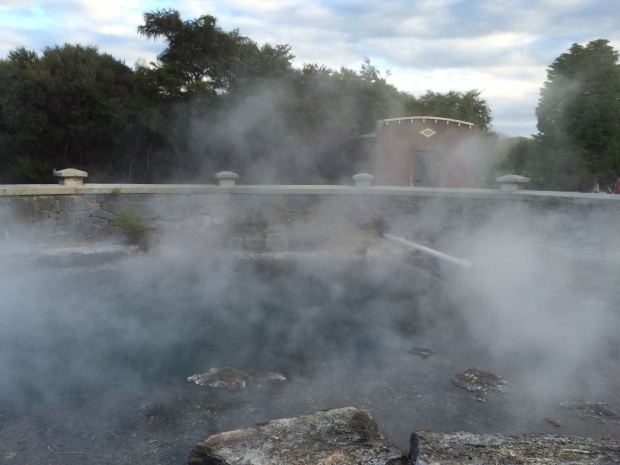
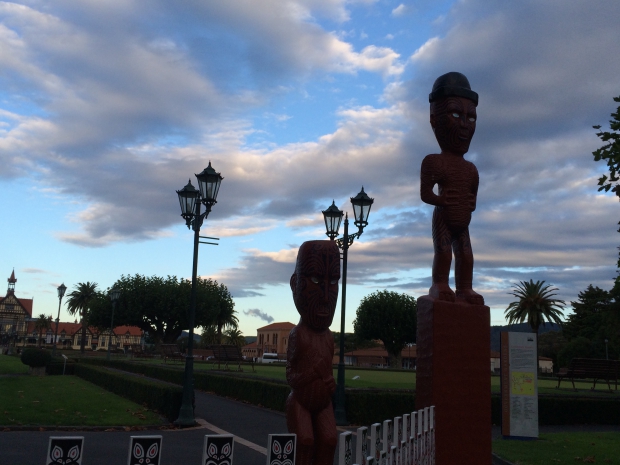
En poursuivant votre navigation sur ce site, vous acceptez l'utilisation de cookies. Ces derniers assurent le bon fonctionnement de nos services. En savoir plus.
Mardi 5 avril le soir
La ville qui fume de partout grâce à ses sources chaudes

Rotorua - Thuesday, April 5th evening
The city which smokes of everywhere thanks to its hot springs


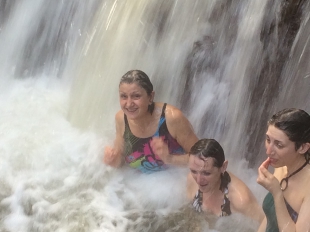 Mardi 5 avril après midi
Mardi 5 avril après midi
Le ruisseau Kerosene
Avec un tel nom on pourrait imaginer le pire ! C’était juste SUBLIME
La surprise de la fin de journée ; notre guide Maxime nous emmène faire un petit plongeon là…
Température de la rivière entre 37 et 38° !
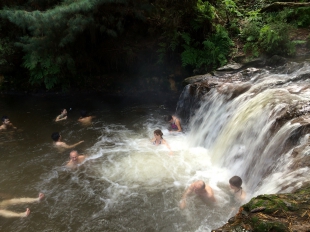 Les cascades comme un spa
Les cascades comme un spa
Agréable massage
Formidable !
"Wild" hot spring
On Thuesday, April 5th afternoon
Kerosene Creek
The surprise of the evening ; Maxime our guide takes us to a dive there
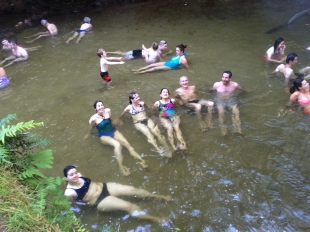 River between 37 and 38°!
River between 37 and 38°!
Falls like a spa
Pleasant massage
Wonderful…
It was just SUBLIME
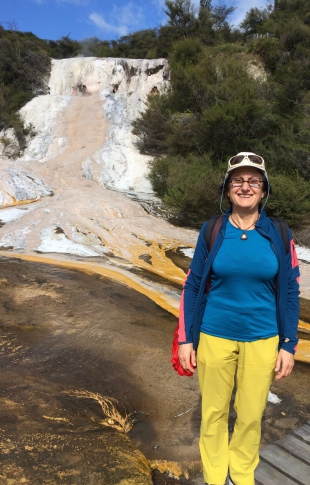 Mardi 5 avril
Mardi 5 avril
Orakei Korako en français signifie: « Le lieu d'ornement »
Voilà ce que dit la publicité : « Sans doute la meilleure zone thermale en Nouvelle Zélande »
Zone géothermique pittoresque, une vallée cachée haute en couleur, des sources chaudes jaillissantes, des geysers et une beauté naturelle à couper le souffle !
Orate Korako - Thuesday, April 5th
Orakei Korako into English means : « The place of adorning »
This is what the advertising says : « Arguably the best thermal area left in New Zealand »
Picturesque geothermal area, a hidden valley of color, hot springs gushing geysers and breath taking natural beauty!
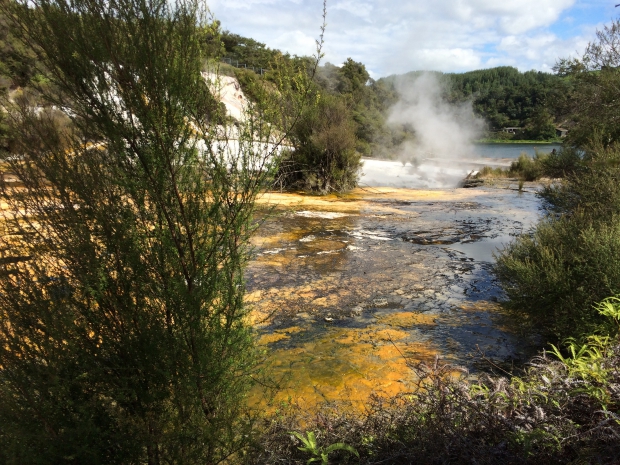
Promenade / Walk
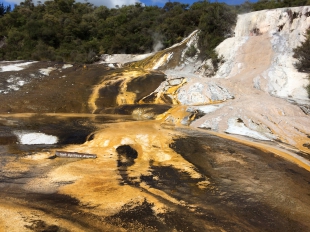
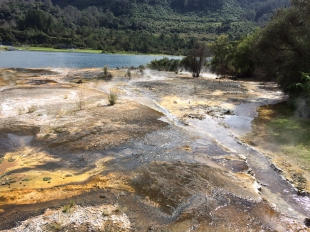
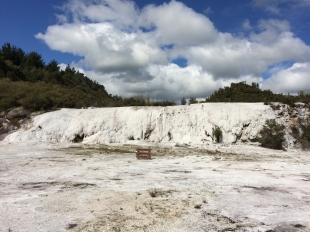
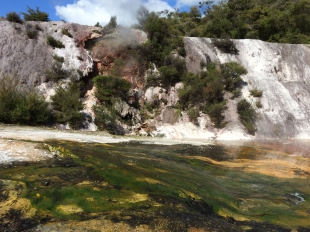
Il y a une forte odeur de soufre / They are a strong sulfur odor
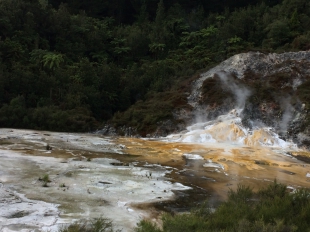
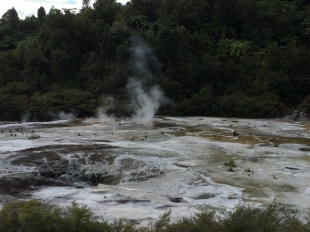

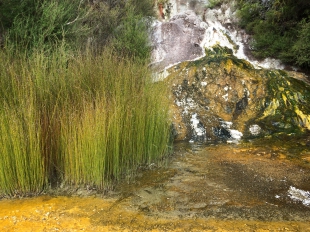
On ne s’en lasse pas, même si ça sent...
One does not weary oneself any, even if that feels…
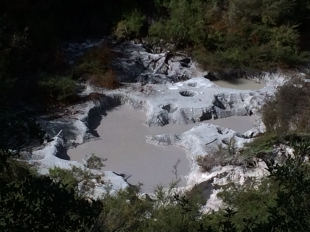
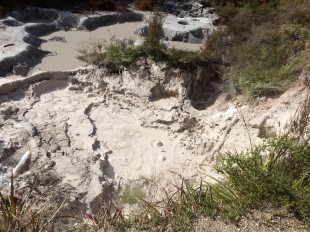
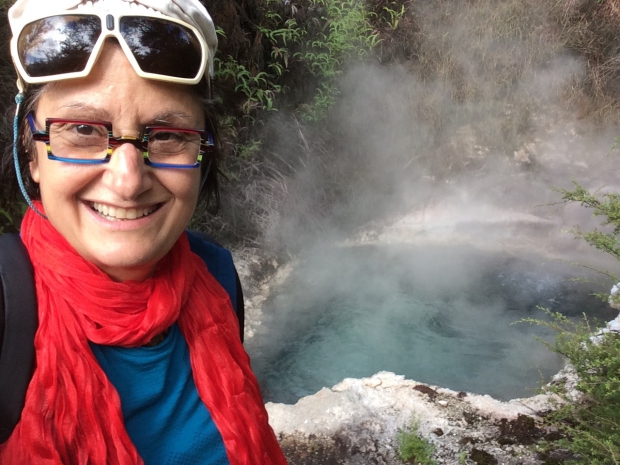
Mardi 5 avril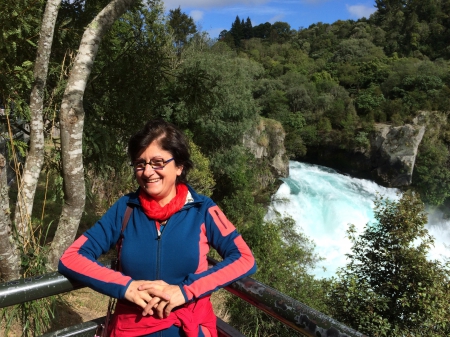 Environ 200.000 litres d'eau plongent les neuf mètres de la grande paroi rocheuse, chaque seconde, aux Chutes de Huka - c’est assez pour remplir cinq piscines Olympiques chaque minute. Un tel flux si important d'eau crée un courant sous-marin dangereux au fond des chutes, ceci a endommagé les embarcations de beaucoup d'utilisateurs fluviaux assez imprudents pour essayer de naviguer sur les chutes.
Environ 200.000 litres d'eau plongent les neuf mètres de la grande paroi rocheuse, chaque seconde, aux Chutes de Huka - c’est assez pour remplir cinq piscines Olympiques chaque minute. Un tel flux si important d'eau crée un courant sous-marin dangereux au fond des chutes, ceci a endommagé les embarcations de beaucoup d'utilisateurs fluviaux assez imprudents pour essayer de naviguer sur les chutes.
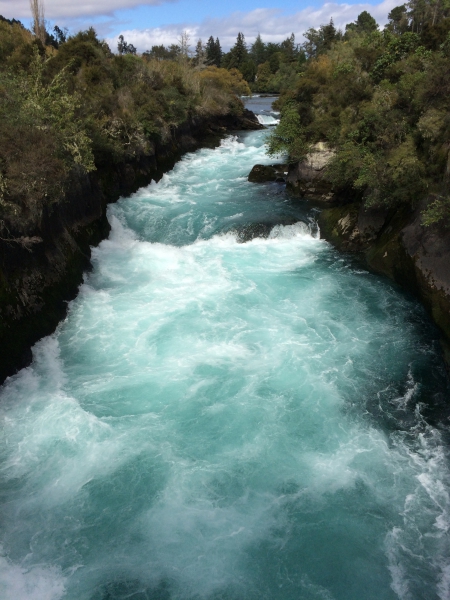 En amont des chutes, le Waikato (plus long fleuve de Nouvelle-Zélande, 425 kilomètres de sa source à la mer, au sud d'Auckland) est clair et réfléchissant. Après la plongée sur les chutes, il prend les masses des bulles d'air dégringolantes qui créent des couleurs à couper le souffle et prend le nom de chutes, après le mot maori qui est "la mousse".
En amont des chutes, le Waikato (plus long fleuve de Nouvelle-Zélande, 425 kilomètres de sa source à la mer, au sud d'Auckland) est clair et réfléchissant. Après la plongée sur les chutes, il prend les masses des bulles d'air dégringolantes qui créent des couleurs à couper le souffle et prend le nom de chutes, après le mot maori qui est "la mousse".
Le flux des chutes est si fort qu’il empêche la migration en amont des truites et des poissons comme les anguilles, c'est pourquoi il n'y a aucune anguille qui puisse 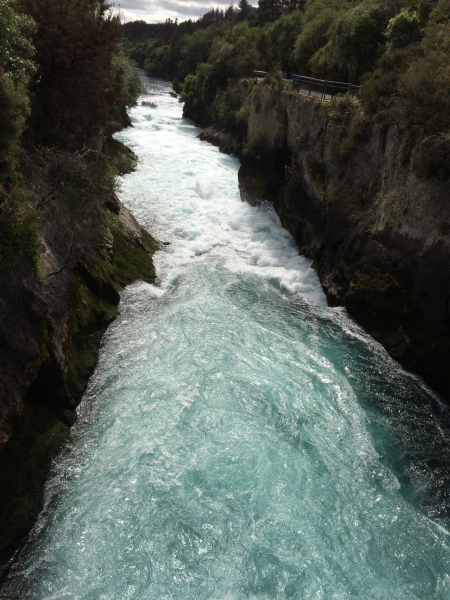 être trouvée dans le Lac Taupo.
être trouvée dans le Lac Taupo.
Power of the water Tuesday, April 5th
About 200.000 litres of water plunge nine metres over the great rock face to Huka Falls every second – that’s enough to fill five Olympic swimming pools every minute. Such a momentous flow of water creates a dangerous undertow at the bottom of the falles, this has claimed the craft of many river users foolhardy enough to try to navigate the falls.
Upstream of the falls, the Waikato (New Zealand’s longest river, at the start of 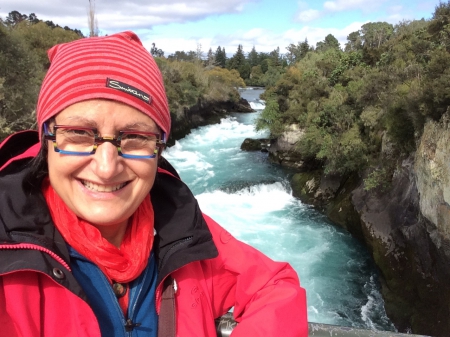 its 425-kilometre journey to the sea south of Auckland) is clear and reflective. After plunging over the falls it picks up masses of tumbling air bubbles which create breathtaking colours and give the falls name, after the maori word for « foam ».
its 425-kilometre journey to the sea south of Auckland) is clear and reflective. After plunging over the falls it picks up masses of tumbling air bubbles which create breathtaking colours and give the falls name, after the maori word for « foam ».
The flow avec the falls is so strong it prevents the upstream migration of trout and native fish such as eels which is why there are no eels to be found in Lake Taupo.
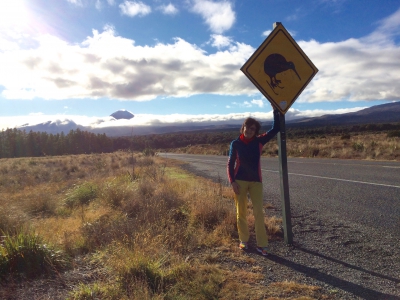 Mardi 5 avril 2016
Mardi 5 avril 2016
Nous quittons Tongariro pour la région des sources chaudes de Rotorua. Dernier coup d'oeil au volcan qui surgit des nuages au loin !
Haka - Tuesday, April 5th
We leave Tongariro for the region of the hot springs of Rotorua. Last look in the volcano which appears from clouds far off!
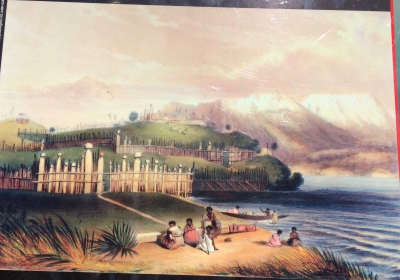 En route nous nous arrêtons au lieu où le Haka est né à Opotoka
En route nous nous arrêtons au lieu où le Haka est né à Opotoka
C’est l’histoire du guerrier Te Rauparaha poursuivi par ses ennemis ; il trouve refuge près du lac Rotoaira. Il reste caché pendant les pourparlers du chef ami Te Wharerangi (« l'homme velu ») avec les ennemis. Il répète sans arrêt les paroles de ce que deviendra le Haka
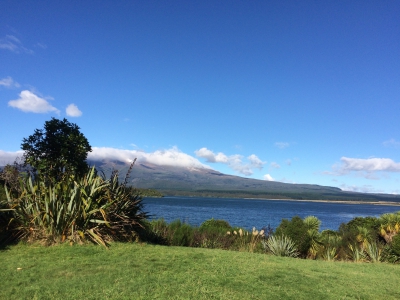 On the way we stop us in the place where Haka was born to Opotoka.
On the way we stop us in the place where Haka was born to Opotoka.
It is the story of the warrior Te Rauparaha pursued by his enemies; he finds refuge near the lake Rotoaira. There is hidden, during the negotiations of the friendly leader Te Wharerangi (« hairy man ») with the enemies. He repeats non-stop the words of the fact what will become Haka
Te Rauparaha a composé le Ka Mate autour de 1820 comme une célébration de la vie sur la mort.
Te Rauparaha composed Ka Mate around 1820 as a celebration of the life on the death.
H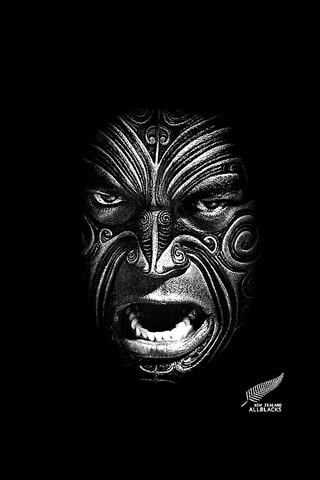 aka
aka
Ka mate, ka mate! ka ora! ka ora!
Ka mate! ka mate! ka ora! ka ora!
Tēnei te tangata pūhuruhuru
Nāna nei i tiki mai whakawhiti te rā
Ā, upane! ka upane!
Ā, upane, ka upane, whiti te ra!
Vais-je mourir, vais-je mourir ! Vais-je vivre vais-je vivre !
Vais-je mourir, vais-je mourir ! Vais-je vivre vais-je vivre !
C’est l’homme aux cheveux long
Qui est allé chercher le soleil et l’a fait briller à nouveau
Je marche vers le haut, je marche à nouveau !
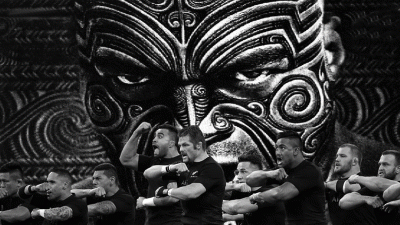 Un pas vers le haut, un autre… le soleil brille !
Un pas vers le haut, un autre… le soleil brille !
Tis death! 'tis death! (or: I may die) ’Tis life! ‘tis life! (or: I may live)
’Tis death! ‘tis death! ’Tis life! ‘tis life!
This is the hairy man
Who brought the sun and caused it to shine
A step upward, another step upward!
A step upward, another... the sun shines!
« Motuopuhi » è Est la forteresse è Is the fortress
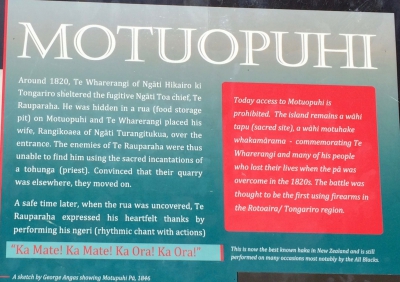 Autour de 1820, Te Wharerangi de Ngati Hikairo Ki Tongariro a abrité le chef fugitif Ngati Toa, Te Rauparaha. Il a été caché dans un « rua » (la fosse de stockage alimentaire) sur Motuopuhi et Ta Wharerangi a placé sa femme, Rangikoaea de Ngati Turangitukua, devant l'entrée. Les ennemis de Te Rauparaha n'ont pas pu ainsi le trouver utilisant
Autour de 1820, Te Wharerangi de Ngati Hikairo Ki Tongariro a abrité le chef fugitif Ngati Toa, Te Rauparaha. Il a été caché dans un « rua » (la fosse de stockage alimentaire) sur Motuopuhi et Ta Wharerangi a placé sa femme, Rangikoaea de Ngati Turangitukua, devant l'entrée. Les ennemis de Te Rauparaha n'ont pas pu ainsi le trouver utilisant  les incantations sacrées d'un « tohunga » (un prêtre). Convaincu que leur gibier était ailleurs, ils se sont remis en route.
les incantations sacrées d'un « tohunga » (un prêtre). Convaincu que leur gibier était ailleurs, ils se sont remis en route.
Around 1820, Te Wharerangi of Ngati Hikairo Ki Tongariro sheltered the fugitive Ngati Toa chief, Te Rauparaha. He was hidden in a « rua » (food storage pit) on Motuopuhi and Ta Wharerangi placed his wife, Rangikoaea of Ngati Turangitukua, over the entrance. The enemies of Te 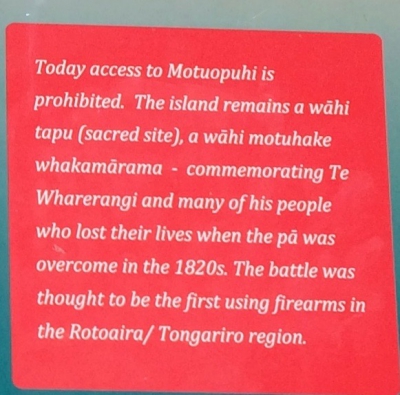 Rauparaha were thus unable to find him using the sacred incantations of a « tohunga » (priest). Convinced that their quarry was elsewhere, they moved on.
Rauparaha were thus unable to find him using the sacred incantations of a « tohunga » (priest). Convinced that their quarry was elsewhere, they moved on.
Aujourd'hui l'accès à Moruopuhi est interdit. L'île reste un « wahi tapu » (site sacré), un « wahi motuhake whakamarama » - commémorant Te Wharerangi et beaucoup de son peuple qui perdirent leur vie quand le « pa » a été surmonté dans les années 1820. La bataille a été pensée pour l’utilisation des premières armes à feu à Rotoaira et dans la région de Tongariro.
Today access to Moruopuhi is prohibited. The island remains a « wahi tapu » (sacred site), a « wahi motuhake whakamarama » - commemorating Te Wharerangi and many of his people who lost their lives when the « pa » was overcome in the 1820s. The battle was thought to be the first using firearms in the Rotoaira / Tongariro region.
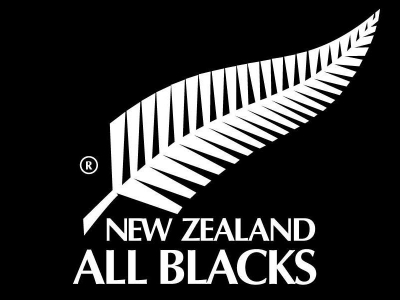
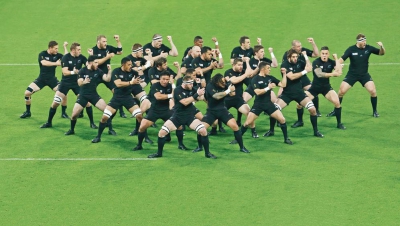 The link between Haka and All black is not recent. It is Joseph Warbrick who in 1888 closely associated the natives of New Zealand and the New Zealand rugby with Haka.
The link between Haka and All black is not recent. It is Joseph Warbrick who in 1888 closely associated the natives of New Zealand and the New Zealand rugby with Haka.
Its mystique has evolved along with the fierce determination, commitment and high level skill which has been the hallmark of New Zealand's National game.